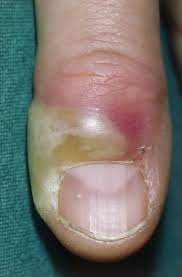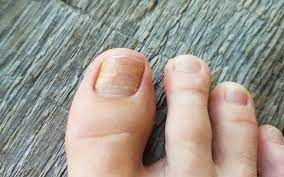Definisi
Paronikia adalah suatu infeksi pada kuku yang memengaruhi lipatan di samping kuku dan perionikium (jaringan di sekitar kuku). Dengan kata lain, paronikia adalah infeksi pada jaringan lunak yang mengelilingi kuku atau kulit di dasar kuku (kutikula) dan biasanya memengaruhi bagian vertikal kuku atau bagian horizontal kuku. Paronikia mungkin terjadi akibat cedera, iritasi, atau infeksi pada kuku. Kondisi ini dapat memengaruhi kuku tangan atau kuku kaki. Paronikia dapat terjadi pada segala usia, baik dewasa maupun anak-anak. Kondisi ini bukanlah suatu gangguan yang serius dan biasanya akan membaik dengan pengobatan.
Secara umum, terdapat dua jenis paronikia dan kedua jenis paronikia tersebut memiliki tanda dan gejala yang mirip, yaitu:
- Paronikia akut di mana gejala muncul dalam rentang waktu beberapa jam atau beberapa hari. Infeksi hanya terjadi pada lipatan kuku dan tidak meluas lebih dalam ke jari tangan atau kaki. Gejala biasanya akan hilang dengan pengobatan dan berlangsung kurang dari enam minggu. Paronikia akut seringkali disebabkan oleh adanya suatu infeksi.
- Paronikia kronis di mana gejala berkembang lebih lambat daripada paronikia akut, dan biasanya berlangsung selama enam minggu atau lebih lama. Beberapa jari tangan atau kaki dapat terinfeksi sekaligus. Sebagian besar kasus paronikia kronis disebabkan oleh iritasi.
Penyebab
Terdapat beberapa penyebab dari timbulnya paronikia akut dan kronis. Penyebab yang mendasari masing-masing kasus secara umum adalah infeksi bakteri, jamur Candida, atau kombinasi dari kedua mikroorganisme tersebut. Beberapa bakteri yang sering menyebabkan paronikia antara lain Staphylococcus aureus dan Streptococcus pyogenes. Beberapa penggunaan obat juga dapat menyebabkan paronikia, termasuk retinoid, obat anti kanker, obat HIV, dan beberapa jenis antibiotik.
- Paronikia akut
Bakteri yang masuk ke area sekitar kuku Anda akibat beberapa jenis tindakan/cedera biasanya akan menyebabkan infeksi paronikia akut. Hal ini bisa disebabkan dari beberapa aktivitas, seperti menggigit atau mencungkil kuku Anda, tertusuk oleh alat manikur, menekan kutikula Anda terlalu agresif, dan jenis cedera lain, seperti sayatan atau kulit yang rusak. Selain itu, kuku yang tumbuh ke dalam juga dapat memicu infeksi bakteri.
- Paronikia kronis
Penyebab infeksi pada paronikia kronis yang paling sering adalah jamur Candida, tetapi bisa juga disebabkan oleh bakteri. Karena jamur biasanya tumbuh dengan baik di lingkungan yang lembap, infeksi ini sering kali disebabkan karena kaki atau tangan Anda terlalu sering terkena air. Paparan air berulang atau bahan kimia dapat menyebabkan iritasi pada kuku.
Faktor Risiko
Paronikia akut dapat menyerang siapa saja. Namun, risikonya akan meningkat jika terdapat kerusakan pada kulit, terutama di antara lipatan/kutikula kuku dan lempeng kuku, seperti:
- Kuku yang sering digigit atau lipatan kuku yang biasanya sering dicabut
- Pada bayi yang sering mengisap jari atau ibu jarinya
- Setelah melakukan manikur
- Kuku kaki yang tumbuh ke dalam
- Pada penggunaan kuku pahatan atau buatan
- Pengobatan dengan obat retinoid oral (yang dimakan) yang dapat mengeringkan kulit, seperti Acitretin, Isotretinoin
- Penggunaan obat lain, termasuk golongan epidermal growth factor receptor dan BRAF inhibitors, seperti Vemurafenib, Dabrafenib
Risiko paronikia kronis akan meningkat terutama pada orang dengan riwayat dermatitis (eksim) pada tangan, terkena iritasi berulang (akibat penggunaan deterjen atau zat kimia lainnya), atau tangan yang terus-menerus dingin dan basah, seperti pada:
- Peternak sapi perah
- Nelayan
- Bartender
- Pembersih
- Ibu rumah tangga
- Orang dengan sirkulasi darah yang buruk
Paronikia akut dan kronis cenderung lebih sering terjadi pada penderita diabetes atau penyakit kronis lainnya, atau yang memiliki sistem kekebalan tubuh yang melemah akibat penggunaan obat-obatan atau penyakit tertentu.
Gejala
Gejala paronikia akut dan kronis sangat mirip, sebagian besar dapat dibedakan satu sama lain dengan kecepatan timbulnya dan durasi infeksi. Infeksi kronis datang secara perlahan dan berlangsung selama berminggu-minggu, sedangkan infeksi akut berkembang dengan cepat dan tidak berlangsung lama. Gejala biasanya muncul di tempat pertemuan kuku dengan kulit (lipatan kuku dan kutikula). Sisi kuku juga bisa terpengaruh. Gejala paronikia meliputi:
- Nyeri, bengkak, dan nyeri tekan di sekitar kuku.
- Kulit yang merah dan hangat saat disentuh.
- Nanah yang menumpuk di bawah kulit. Abses (kantong berisi nanah) berwarna putih hingga kuning dapat terbentuk pada paronikia.
- Jika tidak diobati, kuku dapat mulai tumbuh tidak normal dan mungkin memiliki tonjolan atau bergelombang. Kuku mungkin terlihat kuning atau hijau, dan bisa kering atau rapuh. Kuku juga dapat terlepas dari dasar kuku.
Diagnosis
Dalam mendiagnosis paronikia, dokter akan mulai dengan melakukan wawancara dengan Anda. Dokter akan menanyakan gejala-gejala apa saja yang Anda alami, sejak kapan gejala timbul, serta faktor-faktor risiko yang mungkin berperan terhadap timbulnya paronikia. Selanjutnya, dokter akan melakukan pemeriksaan fisik. Dokter akan melihat langsung keadaan kuku dan area sekitar kuku yang terkena. Dokter juga mungkin akan menekan kuku untuk menilai adakah nyeri tekan dan memeriksa tekstur dari permukaan kuku. Pada dasarnya, diagnosis paronikia dapat ditegakkan berdasarkan hasil wawancara dan pemeriksaan fisik tanpa perlu dilakukan pemeriksaan penunjang tambahan. Namun, terkadang dokter dapat mengambil sampel jaringan dan mengirimkannya ke laboratorium untuk menguji penyebab infeksi tertentu seperti bakteri atau jamur. Pada kasus yang sangat jarang, jika infeksi sangat parah, dokter mungkin menyarankan pemeriksaan pencitraan (seperti sinar-X) untuk memeriksa keterlibatan tulang di bawahnya.
Tata Laksana
Tata laksana paronikia akan bervariasi sesuai dengan tingkat keparahan dan jenis dari paronikia (akut atau kronis). Perawatan di rumah dan perawatan medis dapat membantu, tergantung pada diagnosis dan tingkat keparahan kondisinya.
- Perawatan di rumah
Penderita paronikia akut ringan dapat mencoba merendam jari tangan atau kaki yang terkena dalam air hangat beberapa kali sehari. Jika gejala tidak membaik, mungkin diperlukan pengobatan lebih lanjut.
Paronikia kronis mungkin memerlukan perawatan selama berminggu-minggu atau berbulan-bulan. Sangat penting untuk menjaga agar tangan atau kaki tetap kering dan bersih. Jika pekerjaan Anda mengharuskan tangan basah atau terpapar kuman, maka mungkin diperlukan istirahat sejenak untuk tidak bekerja.
- Perawatan medis
Ketika infeksi bakteri menyebabkan paronikia akut, dokter dapat merekomendasikan penggunaan antibiotik, seperti Dikloksasilin atau Klindamisin. Jika infeksi jamur menyebabkan paronikia kronis, dokter akan meresepkan obat antijamur. Obat antijamur yang diresepkan biasanya berupa obat oles golongan klotrimazol atau ketokonazol.
Jika terbentuk abses pada kuku, dokter mungkin juga perlu mengeluarkan nanah dari abses di sekitarnya. Untuk melakukan ini, akan dilakukan prosedur yang disebut sebagai metode insisi dan drainase. Dokter akan memberikan obat bius lokal, kemudian membuka lipatan kuku sehingga cukup untuk memasukkan kain kasa untuk membantu mengalirkan nanah.
Komplikasi
Sebagian besar kasus paronikia akan merespon pengobatan dengan baik. Namun, terkadang komplikasi bisa tetap terjadi. Pada beberapa kasus yang jarang terjadi, paronikia dapat menyebabkan kerusakan permanen pada kuku Anda. Jika Anda menderita diabetes, terdapat risiko paronikia dapat menyebar ke jaringan dan tulang yang lebih dalam, atau ke aliran darah dan bagian tubuh lainnya. Dalam kasus infeksi yang parah, paronikia dapat menyebabkan hilangnya jari tangan atau jari kaki.
Pencegahan
Beberapa langkah yang dapat Anda lakukan untuk mencegah paronikia, antara lain:
- Hindari menggigit atau mengunyah kuku dan jangan mengorek kutikula kuku Anda.
- Berhati-hatilah untuk tidak memotong kuku Anda terlalu pendek. Saat memotong kutikula, hindari memotong terlalu dekat dengan lipatan kuku.
- Jaga kebersihan dengan mencuci tangan dan menjaga kebersihan kuku. Gunakan sabun lembut yang tidak mengiritasi kulit Anda.
- Gunakan lotion pada lipatan kuku dan kutikula jika kulit Anda kering. Kekeringan yang berlebihan dapat menyebabkan kulit pecah-pecah.
- Gunakan sarung tangan tahan air jika Anda bekerja dengan bahan kimia atau tangan Anda akan basah untuk waktu yang lama.
Kapan Harus ke Dokter ?
Jika gejala paronikia yang Anda alami cukup ringan, Anda dapat mencoba perawatan di rumah. Namun, jika pengobatan di rumah belum mengurangi gejala atau gejala paronikia bertambah berat, segera konsultasikan diri Anda ke dokter.
Mau tahu informasi seputar penyakit lainnya? Cek di sini, ya!
- dr Nadia Opmalina
Balentine, Jerry R. Paronychia (Nail Bed Infection). (2020). Retrieved 11 Mei 2022, from https://www.emedicinehealth.com/paronychia_nail_infection/article_em.htm
Ellis, Mary Ellen. Paronychia. (2018). Retrieved 11 Mei 2022, from https://www.healthline.com/health/paronychia
Kandola, Aaron. How to Treat Paronychia (An Infected Nail). (2021). Retrieved 11 Mei 2022, from https://www.medicalnewstoday.com/articles/324059
Leggit, Jeffrey C. Acute and Chronic Paronychia. (2017). Retrieved 11 Mei 2022, from https://www.aafp.org/afp/2017/0701/p44.html
Nail Infection (Paronychia). (2021). Retrieved 11 Mei 2022, from https://my.clevelandclinic.org/health/diseases/15327-nail-infection-paronychia
Oakley, Amanda. Paronychia. (2017). Retrieved 11 Mei 2022, from https://dermnetnz.org/topics/paronychia
Paronychia. (2018). Retrieved 11 Mei 2022, from https://familydoctor.org/condition/paronychia/
Saleh, Naveed. An Overview of Paronychia. (2021). Retrieved 11 Mei 2022, from https://www.verywellhealth.com/paronychia-treatment-1124156










